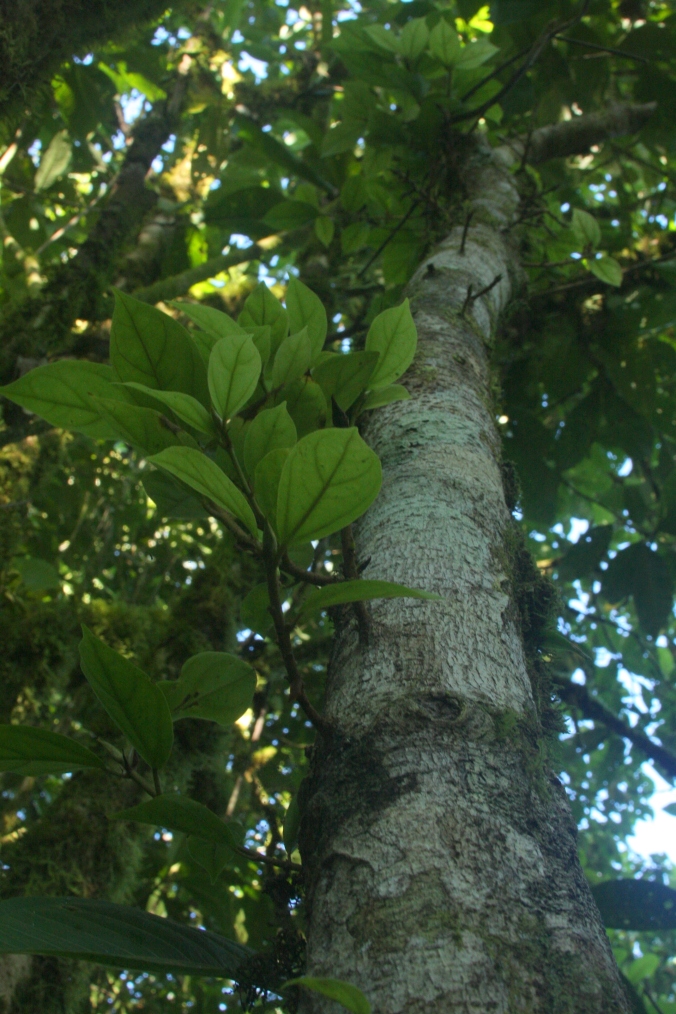Benjamin E. Smith is a Ph.D. student at George Washington University. He recently completed a field ecology course with the Organization for Tropical Studies in Costa Rica, where he worked with CCSD scientist Leighton Reid. When he’s not coring fig trees in Costa Rica, Benjamin studies plant-herbivore interactions in American chestnut.
It was my recent privilege to spend a week at Las Cruces Biological Station in Costa Rica where I learned about some amazing properties of fig trees.
The genus Ficus contains over 800 species, which can be found in the tropical to warm temperate regions throughout the world. Where they occur, figs are vital components of their local ecosystems because they provide high quality fruits for many animals. Animals attracted by the delicious figs often carry other plants’ seeds in their digestive tracks and subsequently deposit them below the fruiting fig tree. This can lead to patches of forest with especially high plant diversity.

Two individuals of Ficus obtusifolia demonstrating the strangler lifestyle (left) and the free-standing lifestyle (right). The individual on the left has overtaken one host tree and is reaching out to claim another. The individual on the right was planted (either by humans or birds) in a fence row.
Some fig species have the ability to resprout roots, branches, and leaves from broken limbs – an adaptation that would be useful in an ecosystem with frequent disturbances, like hurricanes or landslides. Rural people have been utilizing this incredible feat of nature to create living fences for hundreds of years; they simply cut branches from a tree and plant them. Plant a large enough branch, and you’ve got an instant tree.
Instant fruiting trees could be a practical tool for ecological restoration, and there is currently an experiment underway to test this idea. But not all fig species can resprout from cuttings, so in order for this tool to be useful outside of southern Costa Rica, it would be helpful to know which species will resprout and which will not.

A healthy cutting of Ficus colubrinae. This instant tree was planted in May 2015.
Does wood density predict resprouting in figs?
We sought a way to determine whether a particular fig species would be able to resprout from a limb cutting before actually cutting apart large trees. This would mean only trees whose cuttings will survive would be used and trees that can’t resprout could be left undamaged.
We believed that wood density would be a good measure to figure this out. Wood density can tell you a lot about a tree’s life history strategy. Is it a hard tree that will resist snapping in a stiff breeze? Or is it a softer tree that might break, but then resprout?
To test this, we took core samples from seven fig species and headed to the lab. After a couple days of measurements, we had our data.

(A) OTS student Orlando Acevedo Charry extracts a core from a Ficus colubrinae. (B) Cores were cut into small pieces. We measured the mass of the water that each segment displaced to determine the wood’s green volume. (C) Next, samples were placed in a drying oven at 106° C for 24 hours. Finally, we measured the mass of the dried samples and divided by the green volume to determine wood density.
The fig species we tested turned out to have pretty similar wood densities. Also, the slight variations in wood density did not correlate with trees’ resprouting abilities. This initially came as a big disappointment, but after taking a second look at our data we started to see a trend that may actually be much cooler.

Wood density was a poor predictor of resprouting capacity (measured by tallying fig cuttings that were planted in April-May 2015; Left), but strangler figs in the subgenus Urostigma performed much better than two free-standing species in subgenus Pharmacosycea.
Fig species come in a variety of forms. Some are rather conventional free-standing trees that grow from the ground up, but others start as seedlings high in the canopy of another tree and send roots down to the ground, gradually strangling their host. Still others are shrubs, climbers, and epiphytes. We found that stakes cut from strangling figs, the ones that initially rely on a host tree, were much more likely to resprout than stakes cut from free-standing fig species. If this holds true, no measurements will be needed in the future. People around the world may be able to tell if a tree will likely sprout from a cutting just by the way it grows.
Pingback: Fig Stakes: Shoreline Restoration for a Costa más Rica | Natural History of Ecological Restoration
Pingback: How to grow instant fig trees to restore rain forests in Costa Rica | Natural History of Ecological Restoration